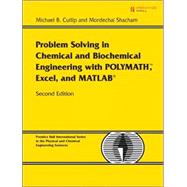
Michael B. Cutlip is an emeritus professor in the Department of Chemical, Materials, and Biomolecular Engineering at the University of Connecticut. He is a coauthor of POLYMATH. His research interests include chemical and electrochemical reaction engineering.
Mordechai Shacham is the Benjamin H. Swig Professor in the Department of Chemical Engineering at the Ben-Gurion University of the Negev. He is a coauthor of POLYMATH . His research interests include analysis, modeling, regression of data, applied numerical methods, and prediction and consistency analysis of physical properties.
| Preface | p. xv |
| Problem Solving with Mathematical Software Packages | p. 11 |
| Efficient Problem Solving--The Objective of This Book | p. 11 |
| From Manual Problem Solving to Use of Mathematical Software | p. 21 |
| Categorizing Problems According to the Solution Technique Used | p. 51 |
| Effective Use of This Book | p. 101 |
| Software Usage with This Book | p. 121 |
| Web-Based Resources for This Book | p. 13 |
| Basic Principles and Calculations | p. 152 |
| Molar Volume and Compressibility Factor from Van Der Waals Equation | p. 152 |
| Molar Volume and Compressibility Factor from Redlich-Kwong Equation | p. 192 |
| Stoichiometric Calculations for Biological Reactions | p. 202 |
| Steady-State Material Balances on A Separation Train | p. 232 |
| Fitting Polynomials and Correlation Equations to Vapor Pressure Data | p. 252 |
| Vapor Pressure Correlations for Sulfur Compounds in Petroleum | p. 332 |
| Mean Heat Capacity of N-Propane | p. 342 |
| Vapor Pressure Correlation Clapeyron Antoine Equations | p. 362 |
| Gas Volume Calculations Using Various Equations of State | p. 382 |
| Bubble Point Calculation for an Ideal Binary Mixture | p. 412 |
| Dew Point Calculation for an Ideal Binary Mixture | p. 442 |
| Bubble Point and Dew Point for an Ideal Multicomponent Mixture | p. 452 |
| Adiabatic Flame Temperature in Combustion | p. 462 |
| Unsteady-State Mixing in a Tank | p. 492 |
| Unsteady-State Mixing in a Series of Tanks | p. 522 |
| Heat Exchange in a Series of Tanks | p. 53 |
| References | p. 56 |
| Regression and Correlation of Data | p. 573 |
| Estimation of Antoine Equation Parameters Using Nonlinear Regression | p. 573 |
| Antoine Equation Parameters for Various Hydrocarbons | p. 613 |
| Correlation of Thermodynamic and Physical Properties of N-Propane | p. 623 |
| Temperature Dependency of Selected Properties | p. 723 |
| Heat Transfer Correlations from Dimensional Analysis | p. 733 |
| Heat Transfer Correlation of Liquids in Tubes | p. 793 |
| Heat Transfer in Fluidized Bed Reactor | p. 803 |
| Correlation of Binary Activity Coefficients Using Margules Equations | p. 813 |
| Margules Equations for Binary Systems Containing Trichloroethane | p. 863 |
| Rate Data Analysis for A Catalytic Reforming Reaction | p. 873 |
| Regression of Rate Data-Checking Dependency Among Variables | p. 893 |
| Regression of Heterogeneous Catalytic Rate Data | p. 933 |
| Variation of Reaction Rate Constant with Temperature | p. 943 |
| Calculation of Antoine Equation Parameters Using Linear Regression | p. 95 |
| References | p. 100 |
| Problem Solving with Excel | p. 1014 |
| Molar Volume And Compressibility From Redlich-Kwong Equation | p. 1014 |
| Calculation Of The Flow Rate In A Pipeline | p. 1104 |
| Adiabatic Operation Of A Tubular Reactor For Cracking Of Acetone | p. 1194 |
| Correlation Of The Physical Properties Of Ethane | p. 1284 |
| Complex Chemical Equilibrium By Gibbs Energy Minimization | p. 144 |
| References | p. 152 |
| Problem Solving with MATLAB | p. 1535 |
| Molar Volume and Compressibility from Redlich-Kwong Equation | p. 1535 |
| Calculation of the Flow Rate in a Pipeline | p. 1655 |
| Adiabatic Operation of a Tubular Reactor for Cracking of Acetone | p. 1735 |
| Correlation of the Physical Properties of Ethane | p. 1825 |
| Complex Chemical Equilibrium by Gibbs Energy Minimization | p. 195 |
| Reference | p. 202 |
| Advanced Techniques in Problem Solving | p. 2036 |
| Solution of Stiff Ordinary Differential Equations | p. 2036 |
| Stiff Ordinary Differential Equations in Chemical Kinetics | p. 2066 |
| Multiple Steady States in a System of Ordinary Differential Equations | p. 2076 |
| Iterative Solution of Ode Boundary Value Problem | p. 2096 |
| Shooting Method for Solving Two-Point Boundary Value Problems | p. 2186 |
| Expediting the Solution of Systems of Nonlinear Algebraic Equations | p. 2236 |
| Solving Differential Algebraic Equations--DAEs | p. 226 |
| Table of Contents provided by Publisher. All Rights Reserved. |
The New copy of this book will include any supplemental materials advertised. Please check the title of the book to determine if it should include any access cards, study guides, lab manuals, CDs, etc.
The Used, Rental and eBook copies of this book are not guaranteed to include any supplemental materials. Typically, only the book itself is included. This is true even if the title states it includes any access cards, study guides, lab manuals, CDs, etc.